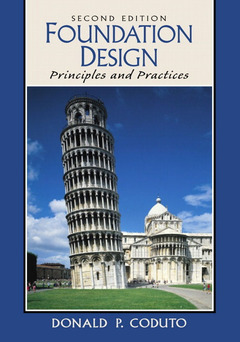Description
Foundation design (2° ed )
Author: CODUTO Donald
Language: English
Approximative price 147.58 €
Subject to availability at the publisher.
Add to cart
Publication date: 08-2000
883 p. · 24.1x17.8 cm · Hardback
883 p. · 24.1x17.8 cm · Hardback
Description
/li>Contents
/li>Comment
/li>
For undergraduate/graduate-level foundation engineering courses. Unlike other undergraduate texts on this subject, this book explores both the principles of soil mechanics and their application to engineering practice emphasizing and explaining how and why foundations behave the way they do. It explains the theories and experimental data behind the design procedures, and how to apply this information to real-world problems.
(NOTE: Most chapters include Questions and Practice Problems, Summary, and Comprehensive Questions and Practice Problems.)
I. GENERAL PRINCIPLES.
1. Foundations in Civil Engineering.
2. Performance Requirements.
3. Soil Mechanics.
4. Site Exploration and Characterization.
II. SHALLOW FOUNDATION ANALYSIS AND DESIGN.
5. Shallow Foundations.
6. Shallow Foundations-Bearing Capacity.
7. Shallow Foundations-Settlement.
8. Spread Footings-Geotechnical Design.
9. Spread Footings-Structural Design.
10. Mats.
III. DEEP FOUNDATION ANALYSIS AND DESIGN.
11. Deep Foundations.
12. Deep Foundations-Structural Integrity.
13. Deep Foundations-Axial Load Capacity Based on Static Load Tests.
14. Deep Foundations-Axial Load Capacity Based
I. GENERAL PRINCIPLES.
1. Foundations in Civil Engineering.
2. Performance Requirements.
3. Soil Mechanics.
4. Site Exploration and Characterization.
II. SHALLOW FOUNDATION ANALYSIS AND DESIGN.
5. Shallow Foundations.
6. Shallow Foundations-Bearing Capacity.
7. Shallow Foundations-Settlement.
8. Spread Footings-Geotechnical Design.
9. Spread Footings-Structural Design.
10. Mats.
III. DEEP FOUNDATION ANALYSIS AND DESIGN.
11. Deep Foundations.
12. Deep Foundations-Structural Integrity.
13. Deep Foundations-Axial Load Capacity Based on Static Load Tests.
14. Deep Foundations-Axial Load Capacity Based
- NEW-Expands coverage of earth retaining structures, with separate full chapters on:
- Sheet pile walls. - Soldier pile walls. - Internally stabilized earth retaining structures - e.g., MSE walls, reinforced earth, and other methods. - NEW-Adds a chapter on LRFD design.
- NEW-Reorganizes the chapters on deep foundations to provide more systematic coverage.
- NEW-Revises coverage of laterally loaded deep foundations to provide more emphasis on p-y analyses.
- NEW-Expands discussions of dynamic methods of deep foundation analysis.
- NEW-Places greater emphasis on the difference between strength requirements and serviceability requirements.
- NEW-Intersperses questions and practice problems throughout each chapter so students have the opportunity to practice the materia
© 2024 LAVOISIER S.A.S.
These books may interest you

The Foundation Engineering Handbook 232.80 €



